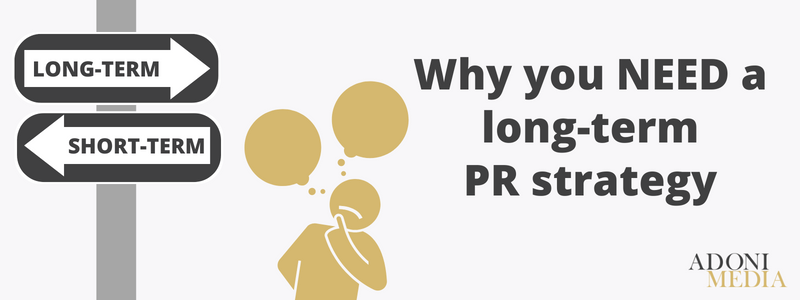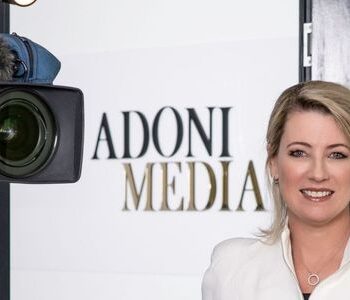Why you need a long-term PR strategy
PR is used to prepare, promote, and protect your brand and reputation. And to do these successfully, you need good PR that is carefully planned to be sustained over a long period of time.
A long-term PR strategy, as opposed to a quick-fix approach, is needed to establish your identity, grow and maintain credibility and trust, and promote a dialogue with your target audience.
Since Adoni Media began in 2012, we have received many requests for help with one-off launches or media announcements. And while these PR activities are powerful and achieve a short burst of interest in your brand because of media coverage, it’s far better to build on that momentum to achieve the best results for your business, organisation, or charity.

Long-term benefits of PR
While first impressions are important, generally people don’t change their behaviour or make a decision after just one news story or social media post. In fact, research shows nearly half of us (47%) only begin to respond or engage with a company or product after we’ve seen three to five articles from or about them – so to be successful, you should be looking to engage a long-term PR strategy.
The key benefits of long-term PR are building a profile through consistently promoting your business name and identity, building a reputation of trust and credibility, and building a plan to strategically engage with the media, particularly in times of crisis.
Building a profile
Repetition is the most important element of building a profile. In this age of news saturation and information overload, reading, watching, or listening just once about an organisation, an event or a milestone announcement isn’t enough.
We don’t start to form long-lasting opinions about a business, product, or person until we start to see and hear about them repeatedly. Publicity can be achieved through business openings, sponsorship announcements, milestone events, anniversary celebrations, or even employee promotions and awards. People and events make news – anything that is of potential interest to your target audience can be used for PR. The greater the awareness of you and your business, the better response you’ll receive from within your industry, your stakeholders, and the wider community.
To build this awareness, you need to build a profile as a thought leader in your industry, or an organisation that has trust and credibility. And to do this, you need a PR strategy that is sustained long-term, and which utilises proactive activity to get your story out there, and reactive media to respond to key events and other opportunities within your industry.
Building a reputation of trust and credibility
Warren Buffett, one of the world’s richest men, once said: “It takes 20 years to build a reputation and five minutes to ruin it. If you think about that, you’ll do things differently”.
So, why not look at PR differently?
Making a long-term effort to build trust and credibility is worthwhile. When some businesses, organisations, or charities plan specific public relations campaigns, the results are measured over months or years, rather than days or weeks.
Developing long-term relationships with journalists is one way to achieve consistent media coverage. Just like everyone else, journalists need to get to know you and your business over time and through multiple stories. Media relations is extremely important in PR, but even more so if you’re conducting a long-term plan that requires repetition to build credibility. It’s human nature – the more they know you and your brand, the more likely they are to run your story. The same goes for a wider audience – if you’re well known to a journalist’s audience, again, the chances of having your story picked up are increased.
When trusted relationships are formed with journalists, they are more likely to come to you for a meaningful comment for a story, in addition to any planned stories you provided. Being considered a ‘go-to’ commentator is a good indication your reputation is growing as a thought leader in your industry. This third-party endorsement by the media oozes credibility and integrity like no paid advertising can ever achieve. It creates positive impressions of you and your organisation that will endure.
Building a strategy of media engagement
So, off the back of media relations, you can start to build a strategy of media engagement that will boost further engagements you have with your industry and with your stakeholders and shareholders, as well as your target audience.
Some publications have long deadlines, anywhere from a week to three months. To integrate these media outlets into your PR strategy, you need to prepare your content at least three months ahead of time. This could affect corporates, businesses, and start-ups wanting to get stories in business magazines, entertainment companies looking for publicity in art outlets, and even small niche organisations hoping for some exposure in lifestyle publications.
Identifying your target audience and determining clear communication goals are also important in the development of a long-term PR strategy. Sticking to the plan is crucial – but so too is being flexible when you need to engage in reactive PR. Being readily available to talk to journalists is one of the most important aspects of making a good PR plan work.
Even short-term projects need PR planning to be done well ahead of time. Key messages need to be identified and distributed to all relevant stakeholders, both external and internal. Do the key spokespeople require media training? If so, how many sessions do they need to speak with confidence in any interview scenario with journalists, including press conferences?
Key message development and media training are both vital PR tools to have in your back pocket if you and your business are suddenly thrust into a media crisis. Time is your enemy in Crisis Communications and so if you can act quickly and with confidence, you can minimise the harm to your reputation. Remember Warren Buffett? It only takes five minutes to ruin it.
So, having a long-term approach to PR gives you a solid foundation to successfully promote your business, your projects, your campaigns, or even your employees’ achievements. Smart, strategic long-term PR planning delivers meaningful results with a positive impact on your bottom line.
If you’d like to work with a PR agency that has been achieving proven results for clients for a decade, contact us.


